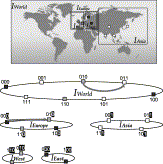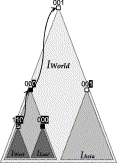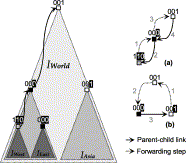Volume 54, Issue 12, 26 August 2010, Pages 1968-1985
P2P Technologies for Emerging Wide-Area Collaborative Services and Applications
|
Copyright © 2010 Elsevier B.V. All rights reserved. |
 Cited By in Scopus (0) Cited By in Scopus (0)
|
 Permissions & Reprints Permissions & Reprints |
Marc Sànchez-Artigas , a,
, a,  , Jordi Pujol-Ahullóa,
, Jordi Pujol-Ahullóa,  , Lluis Pamies-Juareza,
, Lluis Pamies-Juareza,  and Pedro García-Lópeza,
and Pedro García-Lópeza, 
Available online 18 June 2010.
Abstract
Nowadays, we are witnessing an increasing growth of Web 2.0 content such as micronews, blogs and RSS feeds. This trend exemplified by applications like Twitter and LiveJournal is starting to slow down not only by the limitations of existing services – proprietary and centralized, but also by the cumbersome process of discovering and tracking interesting content. This content is generally ephemeral and thus difficult to index by conventional Web search technology. This problem is exacerbated by the passive role adopted by Web content providers: it is surprising that Web servers publish information and expect that thousands of other servers (search engines, Web-based aggregators like GoogleNews, etc.) advertise their content to the world.
In this work we propose p2pWeb, an open, decentralized infrastructure to enable Web servers to use their spare capacity to filter out, aggregate and disseminate Web content in a scalable and timely manner. p2pWeb is flexible enough to support a broad variety of services. The main property of p2pWeb is that all communication abstractions, including aggregation and multicast, are implemented hierarchically and using the HTTP protocol. Simulation results certify the viability of our approach.
Keywords: Distributed systems; Web technology; Peer-to-peer computing; Publish/subscribe
Article Outline
- 1.
- Introduction
- 1.1. Contributions
- 3.
- The p2pWeb infrastructure
- 3.1. Basic architecture
- 3.1.1. Data model
- 3.1.2. Network model
- 3.2. Hierarchical publish/subscribe
- 3.2.1. Dissemination tree construction
- 3.2.1.1. Default tree construction
- 3.2.1.2. Tree construction analysis
- 3.2.1.3. Aggregating dissemination network status
- 3.2.1.4. Tree construction with scoped subscriptions
- 3.2.1.5. Vertical subscriptions
- 3.2.1.6. Horizontal subscriptions
- 3.2.2. Dissemination procedure
- 3.2.2.1. Default dissemination procedure
- 3.2.2.2. Dissemination procedure analysis
- 3.2.2.3. Scoped dissemination procedure
- 3.2.2.4. Dissemination analysis
- 3.2.3. Complexity analysis
- 3.2.3.1. Subscription complexity
- 3.2.3.2. Dissemination complexity
- 3.3. Aggregation
- 4.
- Evaluation
- 5.
- Conclusions
- Appendix A.
- Hierarchical publish/subscribe algorithms
- Appendix B.
- Implementation issues
- B.1.1. Sequentiality issues
- B.1.2. Routing issues
- B.1.3. Hierarchical issues
- B.1.4. Detecting dead links
Vitae

| Marc Sànchez-Artigas is an assistant professor at URV (Tarragona, Spain) in the Department of Computer Engineering and Maths. In 2009, he received his Ph.D. with European Mention from UPF (Barcelona, Spain). During his Ph.D. studies, he worked at EPFL under the supervision of professor Karl Aberer. He received the Best Paper Award from IEEE LCN’07. Contact him at marc.sanchez@urv.cat. |

| Jordi Pujol-Ahulló obtained on September 2002 his B.S. degree in Computer Science Engineering (Software speciality). On June 2005 he obtained his M.S. degree in Computer Science Engineering. Both degrees were attained at Universitat Rovira i Virgili. He obtained his Ph.D. in January 2010 in the University of Murcia about data management and content distribution services on structured peer-to-peer networks, under the guidance of Dr. Pedro García-López and Dr. Antonio F. Gómez-Skarmeta. During his Ph.D. he also worked in the University of Trento (Italy) with Alberto Montresor. His research topics are distributed systems, peer-to-peer networks, distributed middleware and collaborative solutions. |

| Lluis Pamies-Juarez is a Ph.D. student in the Department of Computer Engineering and Mathematics at Universitat Rovira i Virgili, Spain. His research interests include distributed storage systems and peer-to-peer infrastructures. He has a BS and a MS in computer science from Universitat Rovira i Virgili. Department of Computer Engineering and Mathematics (DEIM), Office 144, Campus Sescelades, Avinguda dels Països Catalans, 26, Tarragona, Spain. |

| Pedro García-López is professor at the Computer Engineering and Mathematics Department at the University Rovira i Virgili (Spain) and IEEE Member. He obtained his Ph.D. in 2003 in the University of Murcia about Collaborative Distributed Systems under the guidance of Antonio F. Gomez Skarmeta. During his Ph.D. he also worked in the University of Ghent (Belgium) with Hans Vangheluwe and in Fraunhofer-FIT Bonn (Germany) with Wolfgang Appelt (BSCW team). His research topics are distributed systems, peer-to-peer, software architectures and middleware and collaborative environments. He has published more than 30 papers and participated in several Spanish and European research projects. He currently leads in Tarragona the “Architectures and Telematic Services” research group and coordinates the URV team in the project P2PGRID (Self-Adjusting P2P and Grid Systems). Furthermore, he chairs the IEEE Collaborative Peer-to-Peer Systems Workshop (COPS) and is member of the Program Committee of the IEEE P2P Conference. Contact him at pedro.garcia@urv.cat. |
|
Computer Networks
Volume 54, Issue 12, 26 August 2010, Pages 1968-1985 P2P Technologies for Emerging Wide-Area Collaborative Services and Applications |




 Rerun your search for
Rerun your search for 







 SciClick
SciClick

















